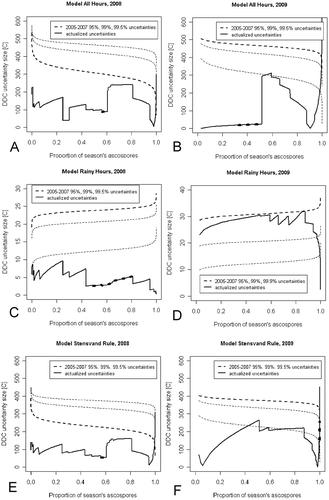Figures & data
Fig. 1 Outline of the proposed method for reducing the limits of uncertainty of the models of ascospore maturation. The outline is based on cumulative proportion of the season’s ascospores trapped (PAT) data from the year 2008, the ‘All Hours’ model, and the observation of the 10th ascospore release in the season. DDC, accumulated degree days in Celsius. The confidence interval of the model is based on data from the years 2005–2007, computed at the 99.5% level of significance. (a) Values of the cumulative temperature and the absolute numbers of ascospores in the subsequent release events. (b) Proportion of seasonal ascospores observed in the subsequent discharges, depending on the assumed total number of ascospores observed in 2008. (c), Extreme layouts of the observed points: first, in which the outermost point lies on the upper confidence band and the second in which the outermost point lies on the lower confidence band. (d), Inclusion of additional points lying on the confidence limits. (e), New updated limits of the model’s uncertainty.
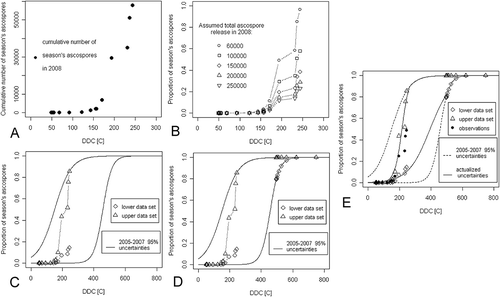
Fig. 2 Visualization of the results of the method for reducing the limits of uncertainty of the models of ascospore maturation. (a) Updated course of uncertainty limits obtained after a new observation of the ascospore discharge. (b) ‘Envelope’ plot of the updated uncertainties calculated for a model after the end of the ascospore release season. (c), (d) Width of the uncertainty interval of the accumulated degree days for a given value of the proportion of season’s ascospores.
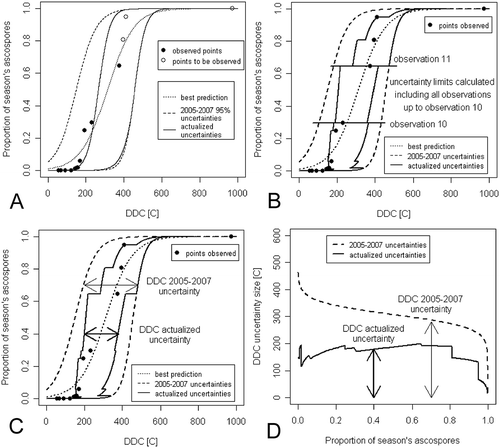
Fig. 3 Results of the calibration of the models used in the study to the cumulative proportion of season’s ascospores trapped (PAT) data, collected in Skierniewice, Poland, in the years 2005–2007. DDC, accumulated degree days in Celsius. (a), ‘All Hours’ model. (b), ‘Rainy Hours’ model. (c), ‘Stensvand Rule’ model.

Fig. 4 Updated limits of uncertainty of the ‘All Hours’ model obtained after the chosen observations of ascospore release events in 2008. (a)–(d), Number of observations equals 8, 14, 20 and 24, respectively. Cumulative proportion of season’s ascospores trapped (PAT), described as a function of accumulated degree days in Celsius (DDC). The full results obtained in each tested model are presented in the form of an animation within the supplementary materials: Suppl. Anim. 1 and Suppl. Anim. 2 for the ‘All Hours’ model, Suppl. Anim. 3 and Suppl. Anim. 4 for the ‘Rainy Hours’ model and Suppl. Anim. 5 and Suppl. Anim. 6 for the ‘Stensvand Rule’ model.
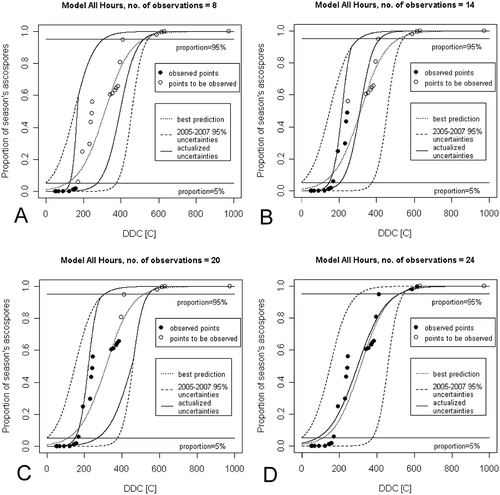
Fig. 5 ‘Envelope’ plots of updated uncertainties of the ascospore maturation models. (a), (b) ‘All Hours’ model. (c), (d), ‘Rainy Hours’ model. (e), (f), ‘Stensvand Rule’ model. Cumulative proportion of season’s ascospores trapped (PAT) described as a function of accumulated degree days in Celsius (DDC). The confidence intervals based on the 2005–2007 data used in each model are highlighted with bold dashed lines. Observations beyond the limits of the updated uncertainty are highlighted with circles. The graphs indicate also the levels of 5% and 95% mature ascospores in the season.
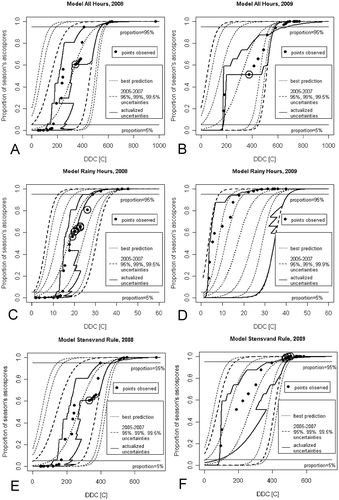
Fig. 6 Predicted uncertainty of the accumulated degree days (in Celsius – DDC), expressed as the width of the uncertainty interval for each observed value of the cumulative proportion of season’s ascospores trapped (PAT). (a), (b), ‘All Hours’ model. (c), (d), ‘Rainy Hours’ model. (e), (f), ‘Stensvand Rule’ model. Uncertainties based on the 2005–2007 confidence intervals, corresponding to three significance levels, 95%, 99% and 99.5% are drawn with dashed lines, with the line corresponding to the significance level chosen for a given model highlighted with the bold line. The updated uncertainties are highlighted with solid bold lines. Areas where the updated uncertainties of cumulative temperature do not contain all experimental points are distinguished with a dashed bold line.
